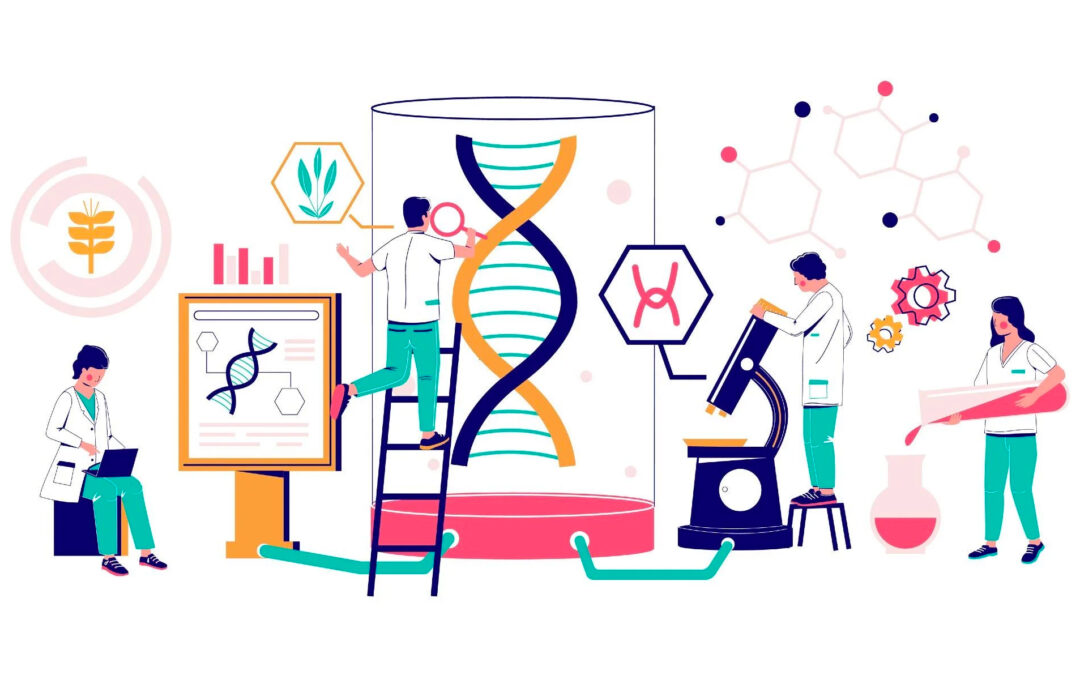Contributing Editors: J. Boen and A. Breckenridge
What is “industrial biology”?
We all know the word “industrial” and some of us studied “biology” in high school or college, but what does “Industrial Biology” really mean? Given there is not an “official” definition at the moment, we would like to offer one for the context of our blog series. We describe industrial biology as the engineering of biological systems, optimized for a specific output at scale. Think of this not as one or two petri dishes, but as hundreds of thousands, or millions of biological environments working together simultaneously to reach a desired outcome. The applications of industrial biology have the potential to displace current components or outputs of legacy, emissions-heavy industrial processes that produce chemicals, materials, pesticides, fertilizers, and even therapeutics. These all make up products or components of products that we interface with frequently in our day-to-day lives. Making the implications of transitioning to a biologically-derived economy relevant not just to a subpopulation of users but to everyone in the world. With the tools we have now, we are discovering the marvels of biology at an ever accelerating pace. These discoveries are providing insights into powerful processes that have survived billions of years of evolution. Our ability to leverage these insights for industrial production of materials/goods we use offers a viable path to a future where humanity can, to the best of our ability, re-establish a symbiotic balance with the planet we inhabit.
Opportunities for a sustainable future
Currently, just about everything produced around us relies upon a petrochemical process to create it. In other words, we depend on oil and gas to make the goods and fuel the services we use everyday. It is the foundation that our modern society has been built upon. The accelerations in industrialization and technological innovation we’ve seen in the last century all have their ties to this foundation but we’re approaching a point where change is a necessity. If we hope to meet the goals set at COP26 last year, we will need to accelerate our transition to industrial biology-based solutions. In a 2021 McKinsey & Co report¹, they stated that 60% of physical inputs in the global economy have the potential to be produced or substituted by biological processes. Meaning, we have only scratched the surface on what industrial biology-based solutions are capable of. These new solutions will hasten large corporations’ ability to meet net-zero by 2050 and bring about the extensive transformation required to address humanity’s challenges in natural resource depletion, climate change, environmental preservation, and healthcare.
Why is now the time?
Synthetic biology that underpins industrial biology has been around for more than twenty years. Well known leaders in the space like Geno, Lanzatech, and Amyris have been in the market for over fifteen years at this point and have the battlescars to show it. Each of these businesses began with different products than the ones we’ve come to know them for today. The reason being that the market evolved over time and there were lessons learned that informed them to pivot! A relevant example for this cohort being the biofuels bust² that wiped out many of their counterparts at the time. This notion of learning hard lessons has been a staple of the industrial biology space over the years as businesses have faced technical, financial, and consumer challenges.
“Failures become victories if they make us wise-hearted” – Hellen Keller
Equipped with the insights gained, industrial biology is reaching an inflection point, where all of the stars are aligning. New product innovations are now more attainable than ever before, prices are becoming cost-competitive to incumbents, and consumers are foaming at the mouth to get their hands on biologically-derived products due to their inherent sustainability benefits. In addition to market readiness, public policy will help provide major tailwinds to drive innovation and adoption: President Biden’s recent executive order³ on biomanufacturing and the inflation reduction act (IRA)⁴ both include major funding initiatives that will catalyze growth for the industrial biology industry.
Challenges ahead
Demand for products seems to be outpacing the available supply. This issue is becoming more apparent as young companies struggle to find the infrastructure that can enable them to meet demand from customers. Such companies face three options: build the infrastructure themselves, utilize a contract manufacturing organization (CMO), or partner with a larger entity in the space to ramp up production. Some of the heavy-hitters in the space mentioned earlier (Geno, Lanzatech, & Amyris) have all invested in building out their own infrastructure because they could not wait for the market to catch up. This has been a grueling journey for them financially but the benefits of taking on this burden will likely be seen in the near future as their capacity enables higher revenues and lower costs, increasing their margins and competitive advantage to incumbents. Biomanufacturing infrastructure is currently the bottleneck for those who lack the means to build their own facilities. Industrial processes and best practices for scaling biomanufacturing are still nascent. Pilot facilities to enable companies to test, validate and iterate their product and process development is lacking, making the investment in biomanufacturing infrastructure an expensive and risky one that investors tend to shy away from.
Tying it all together
While there are enormous challenges to surmount, I’ve never before felt such extraordinary excitement and optimism about the future of industrial biology. This field will continue to offer up never before seen capabilities that will both displace incumbent processes and allow us to increase our likelihood of meeting our climate objectives. As discussed earlier, we are in the early stages of realizing the full potential these technologies have to offer our world. We’ve been able to learn over the years what approaches work and what doesn’t. We’ve also learned what is needed to truly achieve success as an industrial biology-focused company. These playbooks will continue to grow and evolve but for now, they’ve enabled us to prepare for the future and determine what next steps need to be taken. Industrial biology is poised to cause real disruption to numerous verticals in the present, many more in the future and for decades to come. Impacts of industrial biology will be as pervasive and far reaching in the next 20 years, and rival what information technology has accomplished in the last 20 years. It is our conviction that the ability to industrialize biology (the natural processes that created our environment and our species in the first place) will provide humanity the key to a sustainable future.
What does this all mean, and what can we expect? Visit our blog next Thursday when we discuss the sustainability benefits of Industrial Biology.
References:
- McKinsey & Co. biomaterials report: https://www.mckinsey.com/industries/chemicals/our-insights/the-third-wave-of-biomaterials-when-innovation-meets-demand
- Bain & Co. biofuels bust analysis: https://www.bain.com/insights/biofuels-from-boom-to-bust/
- Biden’s executive order on US biomanufacturing: https://www.whitehouse.gov/briefing-room/presidential-actions/2022/09/12/executive-order-on-advancing-biotechnology-and-biomanufacturing-innovation-for-a-sustainable-safe-and-secure-american-bioeconomy/
IRA fact sheet: https://www.whitehouse.gov/briefing-room/statements-releases/2022/08/19/fact-sheet-the-inflation-reduction-act-supports-workers-and-families/


Recent Comments